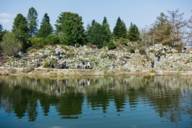
When the botanical garden in Munich is in full colourful bloom, it is almost like stepping into a fairytale.
- General information
- The impressive greenhouses
- The beautiful garden
- History of the Botanical Garden
- Good to know
The scent that fills the gardens when the roses are in bloom is particularly captivating. The sound of insects humming and birds singing fills the air as frogs and toads splash in the ponds between the water lilies and lily pads. Inside the greenhouses, palm trees, orchids, cacti and bright butterflies give visitors the chance to enjoy a moment of summer, even in the depths of winter.
Wandering through the green paradise is like taking a journey around the world. We recommend leaving plenty of time if you are planning a trip to the gardens: After all, the botanical garden stretches over 21 hectares and is home to around 14,000 different species of plants.
The greenhouses are located directly behind the main entrance on the left-hand side. Three large halls, one behind the other, lead off to the side into smaller specialised houses. In the large cactus house, the first large hall, the ball and columnar cacti as well as the impressive agaves are particularly impressive. In the side houses you will find orchids, among other things. If you continue into the second large hall, the palm house, you will find tall tropical plants in a tropical jungle in the tallest and largest glass house. Here, too, there are numerous smaller side houses to discover. The last large hall, the Africa and Madagascar House, is mainly dedicated to spurges, which are similar to cacti. From here you reach the last side house and enter Mexico with its variety of plants.
Directly opposite the entrance to the greenhouses is the Schmuckhof. It is surrounded by dry stone walls and is dedicated to ornamental plants. From the Schmuckhof, the path continues to the colourful spring garden, which really explodes in spring and should definitely be visited at this time of year. The Hortus Conclusus is in the immediate neighbourhood. The small garden won the gold medal at the Chelsea Flower Show and was rebuilt in the Botanical Gardens in 2003. Right next door is the Alpinenhaus, which houses alpine plants alongside the Alpinum and the Alpine Garden.
Located parallel to the spring garden, the ecological-genetic department deals with life forms, plant communities, seed distribution and much more. Behind it is the café in the building with the high round windows. Here you can take a break with coffee and cake.
Behind the café, simply follow the incomparable scent of the roses in the rose garden. From the rose garden, you come to the useful plant garden on the left and the systematic section behind it, where plant species are grouped into plant families. If you continue straight on from the rose garden, you will come to the grove of rhododendrons with over 200 species of rhododendron. The rhododendron grove merges into the shady Fern Gorge to the west. If you follow the stream that runs through the fern gorge, you will reach the large pond with lush water and marsh plants.
The Alpinum, which is one of the most species-rich gardens in Germany, borders directly on the large pond. On the way back to the main entrance, you should admire the various deciduous and coniferous trees in the arboretum (tree garden). In the insect pavilion, you can learn more about the role of bees and butterflies.
Munich’s first botanical gardens were created back in 1812 and were originally located between Stachus square and the central station station, a park which is now known as the Alter Botanischer Garten (the “old botanical gardens”). However, the city soon ran out of space in the centre so new botanical gardens were created in Nymphenburg in 1914. These days, the gardens are an important place of study for gardeners and botanists.
Regular guided tours, speeches and exhibitions offer an in-depth and surprising insight into the world of plants.
Tip: The Botanischer Garten hugs the northern end of Nymphenburg Schlosspark (castle) and can be accessed directly from the park through a secret entrance at the back.
Good to know: Munich Card holders are entitled to a reduced admission fee. If one owns the Munich City Pass, the entrance is free of charge. No matter which card you choose, the public transport is included.